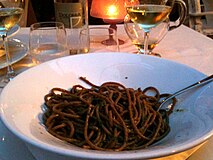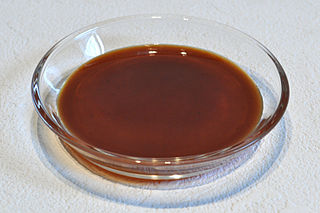
Worcestershire sauce or Worcester sauce is a fermented liquid condiment invented by pharmacists John Wheeley Lea and William Henry Perrins in the city of Worcester in Worcestershire, England, during the first half of the 19th century. The inventors went on to form the company Lea & Perrins.

Fish sauce is a liquid condiment made from fish or krill that have been coated in salt and fermented for up to two years. It is used as a staple seasoning in East Asian cuisine and Southeast Asian cuisine, particularly Myanmar, Cambodia, Laos, Philippines, Thailand, and Vietnam. Some garum-related fish sauces have been used in the West since the Roman times.

In cooking, a sauce is a liquid, cream, or semi-solid food, served on or used in preparing other foods. Most sauces are not normally consumed by themselves; they add flavour, texture, and visual appeal to a dish. Sauce is a French word probably from the post-classical Latin salsa, derived from the classical salsus 'salted'. Possibly the oldest recorded European sauce is garum, the fish sauce used by the Ancient Romans, while doubanjiang, the Chinese soy bean paste is mentioned in Rites of Zhou 20.

A condiment is a preparation that is added to food, typically after cooking, to impart a specific flavour, to enhance the flavour, or to complement the dish.

Garum is a fermented fish sauce that was used as a condiment in the cuisines of Phoenicia, ancient Greece, Rome, Carthage and later Byzantium. Liquamen is a similar preparation, and at times they were synonymous. Although garum enjoyed its greatest popularity in the Western Mediterranean and the Roman world, it was in earlier use by the Greeks. The taste of garum is thought to be comparable to that of today's Asian fish sauces.
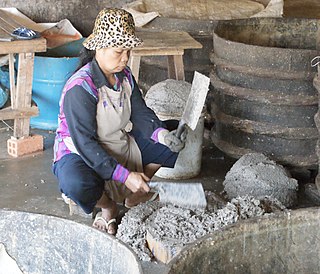
Fish paste is fish which has been chemically broken down by a fermentation process until it reaches the consistency of a soft creamy purée or paste. Alternatively it refers to cooked fish that has been physically broken down by pounding, grinding, pressing, mincing, blending, and/or sieving, until it reaches the consistency of paste. The term can be applied also to shellfish pastes, such as shrimp paste or crab paste.

Bagoóng is a Philippine condiment partially or completely made of either fermented fish or krill or shrimp paste with salt. The fermentation process also produces fish sauce known as patís.

Shrimp paste or prawn sauce is a fermented condiment commonly used in Southeast Asian and Coastal Chinese cuisines. It is primarily made from finely crushed shrimp or krill mixed with salt, and then fermented for several weeks. It is sold either in its wet form or sun-dried and either cut into blocks or sold in bulk. It is an essential ingredient in many curries, sauces and sambal. Shrimp paste can be found in many meals in Cambodia, Indonesia, Laos, Malaysia, Myanmar, the Philippines, Singapore, Thailand, and Vietnam. It is often an ingredient in dip for fish or vegetables.

Gentleman's Relish, also known as Patum Peperium, is a British commercial brand of anchovy paste created in 1828 by John Osborn. It is a savoury paste with a salty and slightly fishy taste, and contains salted anchovies, butter, herbs and spices. Today, the secret recipe is withheld from all but one employee at Elsenham Quality Foods in Elsenham, England, the licensed manufacturer.
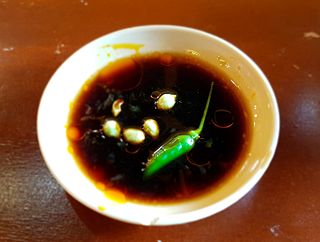
The generic term for condiments in the Filipino cuisine is sawsawan. Unlike sauces in other Southeast Asian regions, most sawsawan are not prepared beforehand, but are assembled on the table according to the preferences of the diner.

Bagoong monamon, bagoong monamon-dilis, or simply bagoong and bugguong munamon in Ilocano, is a common ingredient used in the Philippines and particularly in Northern Ilocano cuisine. It is made by fermenting salted anchovies which is not designed, nor customarily used for immediate consumption since it is completely raw.

Pissalat or pissala, is a condiment originating from the Nice region of France. The name comes from peis salat in Niçard and means 'salted fish'. It is made from anchovy puree flavoured with cloves, thyme, bay leaf and black pepper mixed with olive oil. Pissalat is used for flavouring hors d'oeuvres, fish, cold meats, and, especially, the local specialty, pissaladière.

Myeolchi-jeot (멸치젓) or salted anchovies is a variety of jeotgal, made by salting and fermenting anchovies. Along with saeu-jeot, it is one of the most commonly consumed jeotgal in Korean cuisine. In mainland Korea, myeolchi-jeot is primarily used to make kimchi, while in Jeju Island, meljeot is also used as a dipping sauce. The Chuja Islands, located between South Jeolla and Jeju, are famous for producing the highest quality myeolchi-jeot.

Anchovies are small, common saltwater forage fish in the family Engraulidae that are used as human food and fish bait. There are 144 species in 17 genera found in the Atlantic, Indian, and Pacific Oceans. Anchovies are usually classified as oily fish. They are small, green fish with blue reflections due to a silver longitudinal stripe that runs from the base of the caudal fin. They range from 2 centimetres (0.79 in) to 40 centimetres (16 in) in adult length, and the body shape is variable, with more slender fish in northern populations.
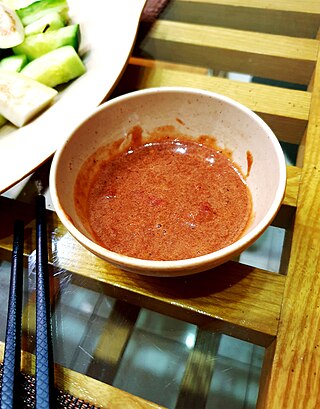
Mắm nêm is a sauce made of fermented fish. Unlike the more familiar nước mắm, mắm nêm is powerfully pungent, similar to shrimp paste. Many of the regions that produce fish sauce, for example Central Vietnam, also produce mắm nêm. It is commonly mixed with sugar, pineapple, and spices to make a prepared sauce called mắm nêm pha sẵn, the key ingredient in neem sauce.

